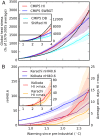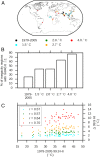Communicating the deadly consequences of global warming for human heat stress
- PMID: 28348220
- PMCID: PMC5393218
- DOI: 10.1073/pnas.1617526114
Communicating the deadly consequences of global warming for human heat stress
Abstract
In December of 2015, the international community pledged to limit global warming to below 2 °C above preindustrial (PI) to prevent dangerous climate change. However, to what extent, and for whom, is danger avoided if this ambitious target is realized? We address these questions by scrutinizing heat stress, because the frequency of extremely hot weather is expected to continue to rise in the approach to the 2 °C limit. We use analogs and the extreme South Asian heat of 2015 as a focusing event to help interpret the increasing frequency of deadly heat under specified amounts of global warming. Using a large ensemble of climate models, our results confirm that global mean air temperature is nonlinearly related to heat stress, meaning that the same future warming as realized to date could trigger larger increases in societal impacts than historically experienced. This nonlinearity is higher for heat stress metrics that integrate the effect of rising humidity. We show that, even in a climate held to 2 °C above PI, Karachi (Pakistan) and Kolkata (India) could expect conditions equivalent to their deadly 2015 heatwaves every year. With only 1.5 °C of global warming, twice as many megacities (such as Lagos, Nigeria, and Shanghai, China) could become heat stressed, exposing more than 350 million more people to deadly heat by 2050 under a midrange population growth scenario. The results underscore that, even if the Paris targets are realized, there could still be a significant adaptation imperative for vulnerable urban populations.
Keywords: CMIP5; climate change; extreme heat; heat stress; megacities.
Conflict of interest statement
The authors declare no conflict of interest.
Figures





References
-
- Fischer EM, Knutti R. Anthropogenic contribution to global occurrence of heavy-precipitation and high-temperature extremes. Nat Clim Chang. 2015;5(6):560–564.
-
- Sheridan SC, Allen MJ. Changes in the frequency and intensity of extreme temperature events and human health concerns. Curr Clim Change Rep. 2015;1(3):155–162.
-
- Dunne JP, Stouffer RJ, John JG. Reductions in labour capacity from heat stress under climate warming. Nat Clim Chang. 2013;3(6):563–566.
-
- Willett KM, Sherwood S. Exceedance of heat index thresholds for 15 regions under a warming climate using the wet-bulb globe temperature. Int J Climatol. 2012;32(2):161–177.
Publication types
MeSH terms
LinkOut - more resources
Full Text Sources
Other Literature Sources
Medical
Molecular Biology Databases
Research Materials
Miscellaneous

